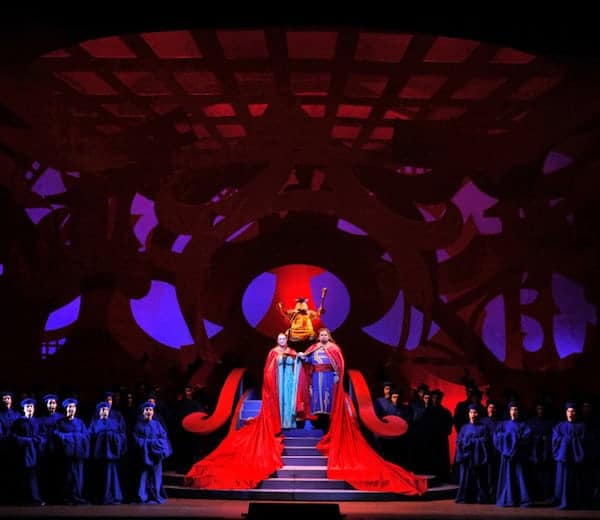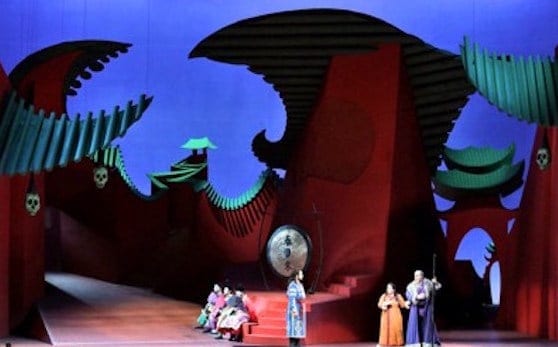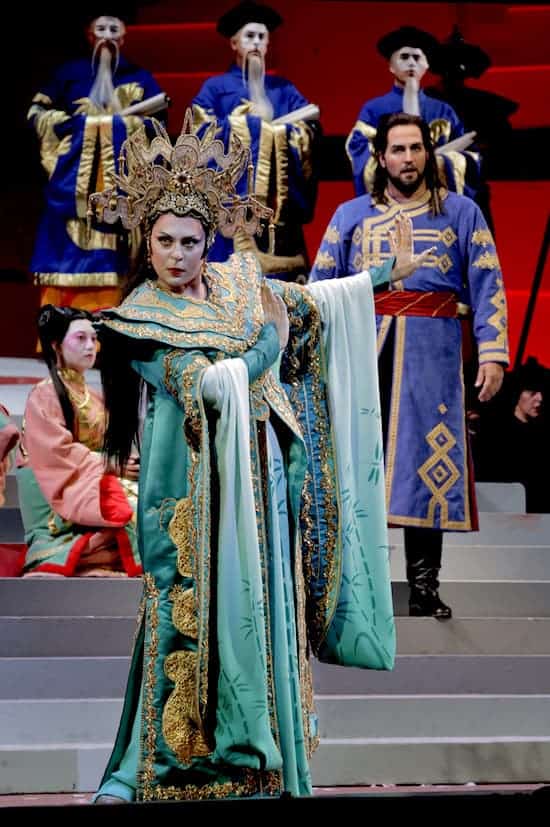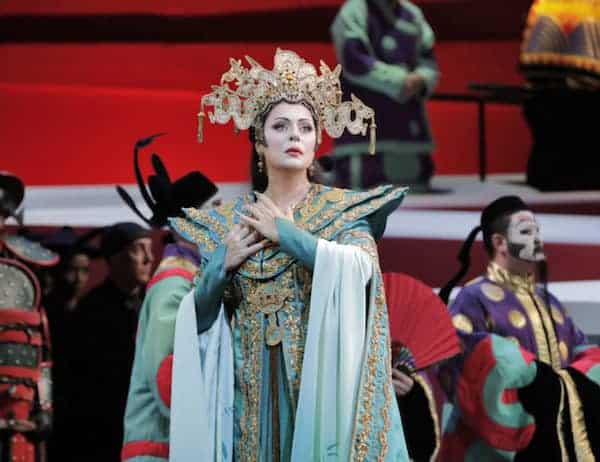Anyone who has seen opera sets by David Hockney remains fairly breathless for days on end. Sometimes years. Rarely has a practicing artist shown such a keen understanding of, and fascination with the playful possibilities of visual storytelling. His sets summon the unconscious foremost by an uncanny fluency with primary colors. Hockney owns red, as the audience for the SF Opera season opener Turandot witnessed with delight last week.

As the curtain came up on the first act of Puccini’s fairytale of old Peking (an Orientalist interpretation of a place that never was)—in which an icy princess Turandot contends with the unknown suitor who will attempt to successfully answer her three riddles—the entire opera house gasped. However many times you’ve feasted on Hockney’s spectral intensity (I’ve been lucky enough to have seen his scenic design in Tristan und Isolde and The Magic Flute) you’re simply not prepared to be so overwhelmed by the sheer saturation of hue.
Now add to that the artist’s set design which seems to occur in at least five spatial dimensions at once, bending and curving rooftops, castle walls, and steep zig-zag stairways so that the stage itself appears to have been pushed into some new, larger-than-life domain.

Hockney knows how the spatial bending, severing, and re-configuring of architecture can form the exact thematic match for the story—in this case a genuine, if unsettling fairytale. [There must be a law somewhere that all opera plots verge on the ridiculous]. Add to all of this Puccini’s dramatically soaring music, alternately romantic and rugged, and you have a masterwork that by all accounts forms the bedrock of entry-level opera. The extraordinary costumes by Ian Falconer, in which the designer’s understanding of design and color contrast is relentless, provided opera costumes that essentially set the bar for the fantasy design universe. Both scenic and costume design are simply in a World Heritage class of their own. Appealing equally to 8-year-olds and 80-year-olds, this Turandot is a brisk 2 hour and 45 minute feast for all of the senses.
First a digression to mention a few details of SF Opera innovation.
Possibly in an effort to open up the opera experience to include new, and younger audiences, this season marks a tentative “experiment” with allowing purchased drinks to be brought into the theater (in plastic cups with tight-fitting lids). I saw only a few such instances last week, e.g. a middle-aged woman had brought her sauvignon blanc in with her and was discreetly sipping it during the second act. The sky did not fall.
 Also, there was something else new—the curtain remained up for a full 20 minutes during the first intermission so that audience could watch some of the fascinating work of moving, altering, and rearranging the key elements of the set. As stage crew—there are 57 working on this production—began altering the stage elements, two production directors explained some of the behind-the-scenes operations to the audience, most of whom stayed to watch. For some of us, this breaks the spell, but for others—who enjoy this sort of backstage revelation seen in the Metropolitan Opera HD simulcasts—it provided an invitation to learn more, and want to see more of live opera.
Also, there was something else new—the curtain remained up for a full 20 minutes during the first intermission so that audience could watch some of the fascinating work of moving, altering, and rearranging the key elements of the set. As stage crew—there are 57 working on this production—began altering the stage elements, two production directors explained some of the behind-the-scenes operations to the audience, most of whom stayed to watch. For some of us, this breaks the spell, but for others—who enjoy this sort of backstage revelation seen in the Metropolitan Opera HD simulcasts—it provided an invitation to learn more, and want to see more of live opera.
Another positive note: the opera house audience appeared to be of a much more mixed demographic, lots of young couples, entire families, and others who broke through the cliché of the white-haired opera-goer. We were overjoyed to see a younger crowd deciding to invest in the magic of live performance. Fingers crossed that this is a trend. [Image below displays Falconer’s playful color choices, pushing primary colors as far as they can go, and then tossing in a splash of purple for added eye candy!]

The power of the San Francisco Opera’s orchestra and chorus brilliantly moved the storytelling toward its several pinnacle arias, including the universally appealing “Nessun dorma” that launched many a tenor’s career. In the September 2017 performances, Brian Jagde sang the heroic suitor, determined to win the hand of the beautiful princess, no matter the sacrifice.

Here is the plum tenor role in all of Puccini (rivalling that of Cavaradossi in Tosca ), and when that moment came in the second act, and the familiar strains of the aria begin, the electricity in the crowd was palpable. Imagine the thrill, the sense of artistic serendipity, to be that tenor, at that moment, on the verge of performing such an iconic line of music. And Jagde was more than up to it. For which the audience unleashed a torrent of cheers and bravos.
 While the gorgeous Martina Serafin looked every inch an imperious princess—imagined by Puccini as an imperial icon of ice and fire—she, much as Nina Stemme in last year’s Met production—had difficulty, especially in the impossibly high and relentess second act aria— her voice struggling with a distracting vibrato as she attempted to maintain the difficult passages. While she regained her vocal beauty in the final scenes (except when she utterly missed the final highest pitches), she seemed to lack the clarity and unforced beauty of soprano Toni Marie Palmertree, who as the luckless Liu was given much the better music to sing. The irony, for me, was that I had come to this particular performance of Turandot specifically to hear Serafin, whom I’d heard as a fabulous Tosca (opposite no less than Jonas Kaufmann) in Vienna in May.
While the gorgeous Martina Serafin looked every inch an imperious princess—imagined by Puccini as an imperial icon of ice and fire—she, much as Nina Stemme in last year’s Met production—had difficulty, especially in the impossibly high and relentess second act aria— her voice struggling with a distracting vibrato as she attempted to maintain the difficult passages. While she regained her vocal beauty in the final scenes (except when she utterly missed the final highest pitches), she seemed to lack the clarity and unforced beauty of soprano Toni Marie Palmertree, who as the luckless Liu was given much the better music to sing. The irony, for me, was that I had come to this particular performance of Turandot specifically to hear Serafin, whom I’d heard as a fabulous Tosca (opposite no less than Jonas Kaufmann) in Vienna in May.
It occurs to me that very likely no soprano can reasonably manage the vocal part of Turandot, and that it’s likely the composer’s fault, writing an all-but-impossible tessitura for this character either out of ignorance (hardly possible) or mischief (?). In other words, the relentless landscape of very high passages might not be singable. Period.
Turandot—the last, and partially unfinished opera that Giacomo Puccini wrote—premiered in Milan in 1926. It was performed the following year at San Francisco, where it has been revived four more times—this year in honor of David Hockney’s 80th birthday, an artist who is obviously having a lot of fun being alive.


